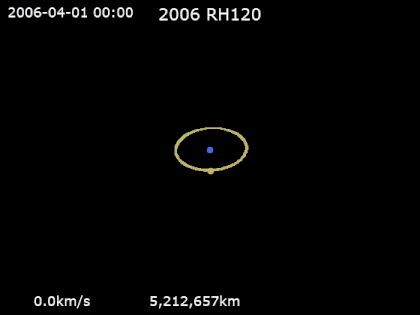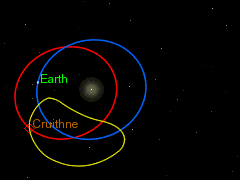고정 헤더 영역
상세 컨텐츠
본문

2006 RH 120 是一顆直徑大約5米的 近地小行星的臨時名字 ,它通常都是繞著太陽公轉,但是大約每20年左右會接近地-月系統一次 。 偶爾這個天體會短暫的進入臨時衛星捕獲(temporary satellite capture,TSC),在臨時衛星捕獲期間,流星體可以是除了月球之外的另一顆天然衛星。。雖然,太空科學. Astronomer Kacper Wierzchos said it was a 'big deal' as 'this is just the second asteroid known to orbit Earth (after 2006 RH120, which was also discovered by the Catalina Sky Survey).; Its route suggests it entered Earth's orbit three years ago, he said. 2006 RH120 - Former Mini Moon of Earth. Eris and Dysnomia. Interstellar Comet Borisov. Interstellar Asteroid Oumuamua. Cruithne - Co-orbital Object of Earth.

From Wikipedia
Discovery | |
|---|---|
| Discovered by | Catalina Sky Survey |
| Discovery date | 14 September 2006 |
Physical characteristics | |
| Dimensions | ~3-4 m |
| Mass | ~1.0 × 103? kg |
| Mean density | 2 ? g/cm³ |
| Rotation period | ? 1.1 h |
| Albedo | 0.1 ? |
| Absolute magnitude (H) | 29-30 |
2006 RH120 is the provisional designation for a small asteroid, with a diameter estimated at two metres[1] which ordinarily orbits the Sun but temporarily enters Earth orbit about every 21 years. It most recently was in Earth orbit from September 2006 to June 2007. Until given a minor planet designation on February 18, 2008, the object was known as 6R10DB9, an internal identification number assigned by the Catalina Sky Survey.[2]
Some controversy existed regarding the origin of the object. Upon discovery, it was not given a formal name since its size and orbit suggested it may have been an artificial object. A precedent for this exists in J002E3, currently thought to be the third stage Saturn S-IVB booster from Apollo 12, in an almost identical orbit.
History
2006 RH120 was discovered on 14 September 2006 by the 27-inch (690 mm) Schmidt camera of the Catalina Sky Survey in Arizona.[3] Preliminary orbital calculations indicated it was captured by Earth's gravity from solar orbit of a period of about 11 months, which is similar to that of many spent rocket boosters dating to the Apollo program of the 1960s and early 1970s. However, later analysis shows the body is not affected by the pressures of solar radiation and must be a dense rocky body or at least regularly shaped. One hypothesis is that the object is a piece of lunar rock ejected by an impact.[4]
'6R10DB9' was the Catalina Sky Survey's own discovery designation for this object, which usually would only be used on the MPC's NEO Confirmation Page (NEOCP) until an IAU designation was applied, if the object was classified as a minor object. It was added on September 14 to the NEOCP and subsequently removed with the explanation that it 'was not a minor planet.'[5] However, the object was later confirmed to be a minor planet.
The object made four Earth orbits before being ejected after the June 2007 perigee. At that perigee, it dipped inside the Moon's orbit to a distance of approximately 200,000 miles (320,000 km).
June 14, 2007 Perigee
On June 14, 2007, 2006 RH120 made its fourth and last perigee of its 2007 encounter. It was 0.7 lunar distances at closest, with an apparent magnitude of 18.5 - 19.0.
Astronomers at JPLGoldstone in California, USA made radarastrometry measurements on June 12, 14 and 17, 2007.
The object is now in solar orbit. A next potential near-Earth encounter will be 2028.
References and footnotes
- ↑'JPL Goldstone Planning Page'. http://echo.jpl.nasa.gov/asteroids/6R10DB9/html/6R10DB9_planning.html. Retrieved 2007-06-07.
- ↑Great Shefford Observatory. '2006 RH120 ( = 6R10DB9) - A second moon for the Earth?'. http://www.birtwhistle.org/Gallery6R10DB9.htm. Retrieved April 16, 2008.
- ↑'Distant Artificial Satellites Observation (DASO) Circular No. 68, 2006 Sept. 17, 16:59 UT'. http://cfa-www.harvard.edu/~gwilliams/DASO/000000/DASO_000068.txt. Retrieved 2007-06-26.
- ↑Bill Gray. 'Pseudo-MPEC for 6R10DB9'. http://home.gwi.net/~pluto/mpecs/6r1.htm. Retrieved August 16, 2007.
- ↑'Major News About Minor Objects, April 18, 2007'. http://www.hohmanntransfer.com/news/0704.htm#news. Retrieved 2007-06-27.
See also
- 6Q0B44E - Another small Earth satellite, probably artificial
- 3753 Cruithne - Another 'Second Moon' candidate
- 2002 AA29 - Potential Earth-orbiting asteroid
External links
- JPL Horizons ephemeris gererator Change target body to '2006 RH120'.
| ||||||
2008 TC3- The world's first asteroid discovered before Earth impact -
Earth Second Moon Appears
In 2008 CSS observer Richard Kowalski discovered the first asteroid in history to be detected before it impacted the Earth. The object, 2008 TC3, was discovered 20 hours before it exploded in the atmosphere above northern Sudan. A team of scientists recovered fragments of the small stony asteroid from the desert floor.

2014 AA- The world's second asteroid discovered before Earth impact -
Another impactor also discovered by CSS observer Richard Kowalski was detected on the last day of 2013. Designated 2014 AA, it impacted into the Atlantic Ocean about 21 hours after discovery. The animation below shows the sequence of the 4 discovery images acquired ~9 minutes apart from the CSS's 60 inch Mt Lemmon telescope.
Figure below shows probable impact location of near-Earth asteroid 2014 AA based on infrasound data from the Comprehensive Nuclear-Test-Ban Treaty Organization. NASA/JPL.
WT1190F - Space junk returns to Earth in fiery passage -
The object WT1190F was discovered in 2015 by CSS observer Rose Matheny. This strange object was determined to be a piece of artificial space debris, possibly a part of the Lunar Prospector mission. Further observations revealed that the Catalina Sky Survey had previously observed this object in 2013. WT1190F burned up in the atmosphere over the Indian Ocean near Sri Lanka later that same year. To understand more about Earth impacting objects, WT1190F was tracked by both ground-based telescopes, and a NASA airborne observatory.
Discovery images of WT1190F from Oct. 3, 2015 10:05 - 10:27 UT, taken by Rose Matheny at CSSs Schmidt telescope on Mt. Bigelow, Arizona. There are 4 still images presented here in an animation and in a 2 x 2 grid. This is actually the fourth time CSS had 'discovered' this object. See Bill Gray's WT1190F FAQ at Project Pluto for more details, particularly concerning its entry into the Earth's atmosphere on Nov. 13, 2015.
2006 RH120- This strange asteroid sometimes orbits the Earth -
Discovered by CSS in September 2006, this so-called Temporarily Captured Object (TCO) (PDF) exhibits an unusual near-Earth orbit wherby the asteoid becomes temporarily transfered into geocentric (Earth) orbit. There is believed to be a very small population of TCOs which are likely sourced from more common near-Earth asteroid orbital families known as Amors and Atens. Their orbits are considered unstable as gravitational energy from the Earth will eventually hurl them away from near-Earth space. In the meantime, the occaisional TCO encounters with Earth and their relatively low velocity make them very attractive targets for space resource exploration. Initially the orbit of 2006 RH120 appeared similar to that of some Apollo-era spent rockets boosters, although as further observational data were acquired and analyzed, the objects 'area-to-mass-ratio' (AMR) conclusively showed it to be a natural asteroid body. Fortunateley, with ever increasing capabilities of NEO surveys it is likely that more TCOs will be discovered in the coming years, allowing for improved defintion and characterization of this strange and rarefied class of near-Earth objects.
Rendezvous transfer boosts to 2006RH120 from a Halo orbit around L2: Inertial Frame (left). Rotating Frame (Right) -after Brelsford et al 2015 (PDF), Rendezvous Missions to Temporarily-Captured Near Earth Asteroids-
Comets:
Collectively the Catalina Sky Survey has discovered >300 comets to date. Included within these totals are the individual comet discoveries by CSS observers, which by convention now bear their respective names. Currently our observer totals for comet discoveries are:
CSS Active Observers
Alex Gibbs: 31
2006 Rh120 Asteroid
Eric Christensen: 24
Richard Kowalski: 14
Gregory Leonard: 10
Earth Has A Second Moon
David Rankin: 7

Steve Larson: 5
Carson Fuls: 4
Hannes Gröller: 2
Teddy Pruyne: 2
Kacper Wierzchos: 1
CSS Former Observers
Could Earth Get Another Moon
Rob McNaught: 82
Richard 'Rik' Hill: 27
Andreas Boattini: 25
Gordon Garradd: 17
Brian Africano: 5
Al Grauer: 3
Carl Hergenrother: 3
2006 Rh120
Tim Spahr: 3
Ed Beshore: 3
Rose Matheny: 2
Jess Johnson: 2






댓글 영역